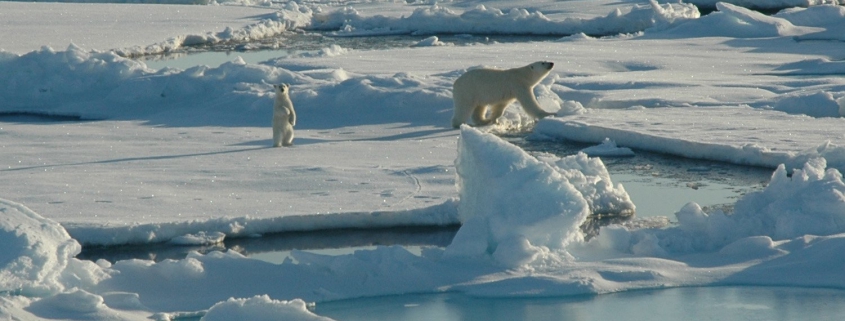Are Polar Bears on Thin Ice?
By: Kaylie Anne Costa, SRC Intern
When you think of polar bears what comes to mind? Is it a mama bear and a cub struggling to swim miles to find a piece of sea ice? Because that is exactly what is beginning to occur in the Arctic. With the rise of the sea surface temperatures, more and more sea ice is thawing causing the polar bears breeding and hunting grounds as well as means for transportation to disappear.

Figure 1: Polar bears using sea ice for transportation (By NOAA Photo Library – anim0115, Public Domain, https://commons.wikimedia.org/w/index.php?curid=17942736)
Polar bears have a varied diet consisting of seals, birds, fish, whales, and other marine resources. They also utilize a mixture of hunting methods. For example, polar bears may stalk seals in the open ocean or sneak up on seals that are drifting on sea ice. When there is not sea ice, polar bears must rely much more heavily on their swimming skills for transportation and hunting.
In a recent study, Lone et. al (2018) studied the time that female polar bears spend in the water to gain understanding as to how polar bears might react to future decreases in Arctic sea ice. 57 adult polar bears were tagged with devices to gather data on their locations, the amount of time spent swimming, and the diving depths. This study showed that polar bears’ choice of hunting strategies, and therefore amount of swimming, greatly depends on the individual. In addition, environmental factors and if the females had cubs also impacts the time a polar bear spends swimming. Polar bear cubs lack the thick layer of fat that insulates their bodies leaving them more susceptible to hypothermia. As a whole, the main variable that influence the swimming behaviors of the polar bears was the seasonal variation in sea ice. The most swimming occurred in summer and fall with less swimming occurred during the winter and spring. Modeling techniques were also used to correlate increased swimming with decreased levels of sea ice.

Figure 2: Polar bear swimming (https://commons.wikimedia.org/wiki/File:Polar_bear_arctic.JPG)
Overall the polar bears appeared well adapted to arctic marine environments and were able to complete long distance swims and dive greater than 10 meters. As sea ice continues to disappear, more polar bears will be required to alter their choices of hunting strategies to adapt to the new environment. This study shows promise in polar bears’ ability to adapt to reduced sea ice, at least to a certain extent. Further studies will need to be completed to analyze the impacts that additional swimming behavior will have on the polar bears health overall.
Works Cited
Lone, K., Kovacs, K. M., Lydersen, C., Fedak, M., Andersen, M., Lovell, P., & Aars, J. (2018). Aquatic behaviour of polar bears (Ursus maritimus) in an increasingly ice-free Arctic. Scientific reports, 8(1), 9677.



